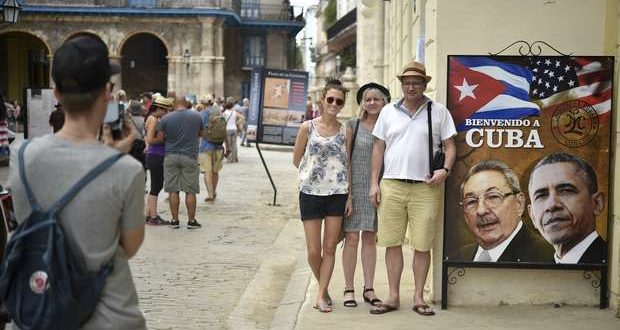
Ivan Garcia, 23 January 2017 — Miami Airport is almost a city. And the American Airlines’ departures area is a labyrinth, with dozens of corridors and passages. That’s why Noahn, an American living in Michigan, arrived five hours before his flight’s scheduled departure time to Varadero.
He was travelling with his wife, his eight-month-old son carried in an arm-sling, and a dog with long floppy ears. In his luggage, professional diving equipment and an electric skateboard. The couple speak in carefully enunciated Spanish, with a hint of a Colombian accent. “It’s because I worked for an American company in Bogotá,” explains Noahn.
To everyone who wants to listen to him, he describes his experiences as a tourist in Cuba. He knows the Coco and Santa Maria Keys, located to the north of Ciego de Avila and Villa Clara and Maria La Gorda, in the western province of Pinar del Rio.
“But I was enchanted by Varadero. It’s the third time in two years I’ve been there since the reestablishment of relations between Cuba and the United States. Neither Miami Beach nor Malibu can compare with Varadero, with its fine white sandy beach. The water is warm and there are hardly any waves. Punta Cana in the Dominican Republic, Copacabana in Rio de Janeiro and The Bahamas may have just as good or better natural conditions,” he adds, while his wife gives the child some milk in a bottle.
Despite the prohibitions on tourism in Cuba, Americans such as Noahn travelled to the island by way of a third country. “Before December 17, 2014, I travelled to Cuba via Mexico. After that date it’s been easier. There are twelve quite flexible categories, which they call the twelve lies. You declare whichever pretext, and travel in a group or individually. “In theory you can’t go as a tourist, but I bet that’s what half of the American travellers are doing.”
Out of more than 200 passengers on the flight heading to Varadero, only six were Cubans going back to their country permanently or to visit relatives on the island.
Judith, a biologist living in Georgia, is going to Cuba for the second time this year. Why? “Half for professional experience, half tourism.” I’m interested in gathering information on the varieties of Cuban vegetation. Once I finish my research, I’m going to stay a week in a hotel full-board in Camaguey or in Holguin.”
Asked if she felt any harassment or if any federal institution has opened a file on her for violating the country’s regulations, she replies: “Not at all. Seems to me the wisest thing to do would be to openly permit tourism in Cuba, because that’s what in reality people are doing.”
After the re-establishment of relations between two countries that were living in a cold war climate, many more Americans are travelling to the Greater Antilles. In January 11, 2016, Josefina Vidal, an official working in the Cuban Foreign Ministry, and responsible for relations with the United States, reported on Twitter that, in 2016, the island received a total of 614,433 visitors from United States (Americans and Cuban Americans), 34% more than in 2015.
Although on paper the Americans arriving are recorded as being part of a religious or journalistic or a people-to-people exchange, it isn’t difficult to spot well-built blonds or redheads downing quantities of mojitos in a bar in Old Havana or enjoying the warm autumn sun on a Cuban beach.
When at 8:30 in the evening, the American Airlines plane landed at the Juan Gualberto Gómez international airport in Varadero, after a quick check, half a dozen air-conditioned buses were waiting for the “undercover” tourists to take them to four and five star hotels along the Hicacos Peninsula coast.
“Yes, the Americans are tourists.” Many of them go to Havana, others pass the time in Varadero. They prefer to stay in hotels. About 400 or 500 come every week. And many more are expected at New Year’s,” said an official of the Gaviota chain, balancing on the stairway of a bus.
Private taxi drivers and those who lease vehicles from the state hang around the terminal. “There are gringos who come as individual tourists. I charge them the equivalent of $40 for the trip to Varadero, about 20 kilometers from the airport. Almost all give good tips. Unlike the Spaniards and Mexicans, who are complete tightwads,” says Joan, a private taxi driver.
The majority of Cubans are convinced that Americans are rich. And have more money than they know what to do with. They try to milk them as if they were cows.
At the currency exchange outside the airport, they exchange dollars for 86 centavos, less than the official rate of 87. “The rate goes down at weekends,” he says.
An employee in the terminal, says “Here everyone is doing business. “The lavatory cleaner charges, the café sells stuff on the side, and the customs people get things off the passengers.”
Tourism in Cuba is like a harvest. Everyone wants to squeeze the sugar cane. And you can extract plenty of juice from the sneaky tourists
Translated by GH
